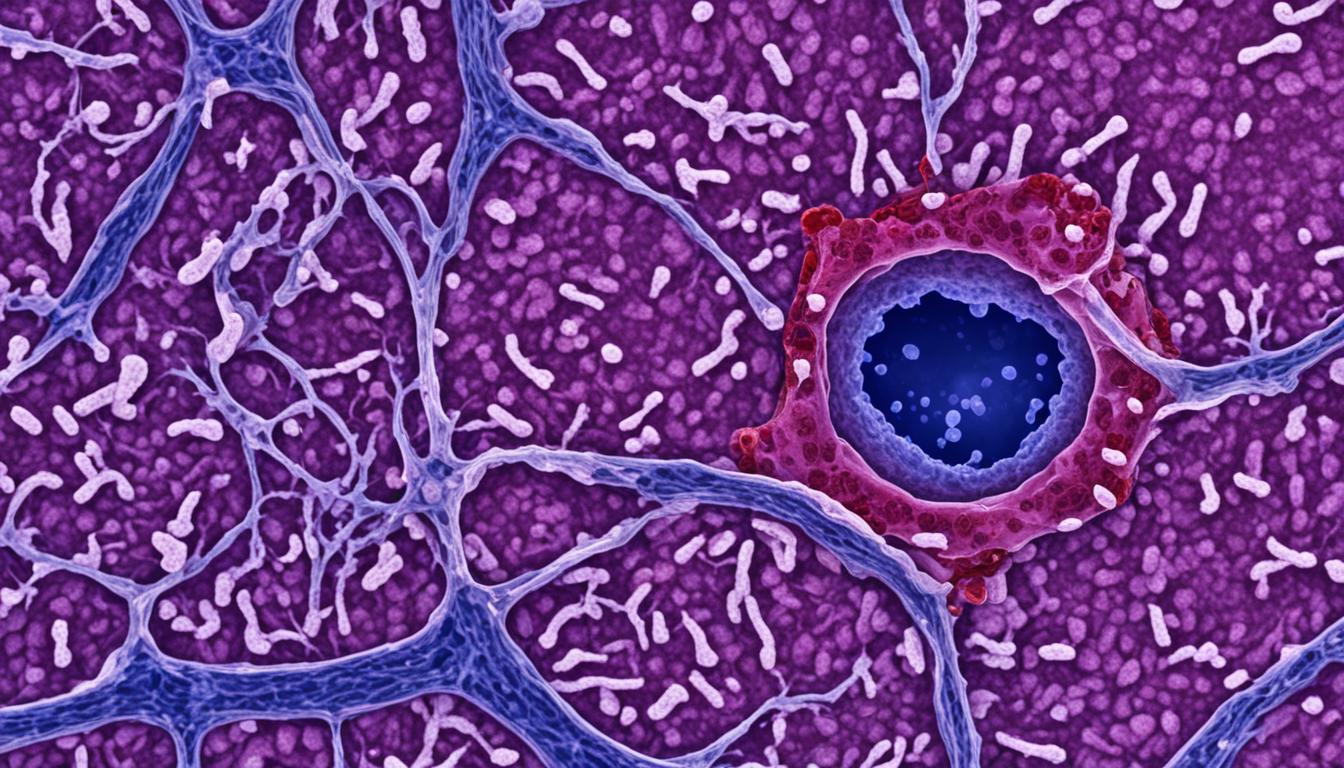Wermer syndrome is rare and known by its other name, multiple endocrine neoplasia type 1 (MEN1 syndrome). This genetic disorder impacts the endocrine system, causing hormone imbalances and tumors in organs like the pituitary, parathyroid, and pancreas.
Issues with the WRN gene are linked to Wermer syndrome. This gene plays a big part in DNA repair and growth. When the gene doesn’t work right, it can lead to signs like looking older, not growing like you should, hair turning gray early, and skin and eye problems. It also might mean you have a higher chance of developing cancer.
Doctors check for Wermer syndrome by looking for signs like bilateral cataracts, changes in the skin, being shorter than usual, and early gray hair. A crucial step in confirming the diagnosis is through genetic testing. This can show if there are any changes in the WRN gene that match with the disease.
At the moment, there isn’t a sure cure for Wermer syndrome. But, there’s good news because stem cell therapy might offer some hope. Special stem cells called induced pluripotent stem cells (iPSCs) show potential in treating genetic conditions like Wermer syndrome. These cells can be made from a patient’s own cells. They might then help fix problems in tissues and organs.
Key Takeaways:
- Wermer syndrome is a rare genetic disorder that affects the endocrine system and causes hormone imbalances and tumor formation.
- The syndrome is characterized by accelerated aging, growth retardation, premature graying of hair, skin atrophy, cataracts, diabetes mellitus, hypogonadism, osteoporosis, and an increased risk of malignancies.
- Diagnosis of Wermer syndrome is based on clinical criteria such as bilateral cataracts, dermatological changes, short stature, and premature graying of hair.
- Genetic testing can confirm the diagnosis by identifying mutations in the WRN gene.
- Stem cell therapy, particularly using induced pluripotent stem cells (iPSCs), shows promise for treating Wermer syndrome and regenerating damaged tissues and organs.
Understanding Werner Syndrome
Werner syndrome (WS) is a very rare condition. It causes people to age quickly. They might also have more risk of getting cancer. This disorder happens because of changes in a gene called WRN.
People with Werner syndrome look like they are aging rapidly. They might lose their hair and their skin changes. Other symptoms include cataracts and diabetes. They are also prone to getting different kinds of cancer.
Experts think WS is linked to other diseases that cause people to look older than they are. They believe this problem might have to do with issues in the WRN gene. This gene usually helps to keep our DNA stable and our telomeres, which cap our chromosomes, from getting too short.
Genetic Disorder with Increased Cancer Predisposition
Werner syndrome is inherited in a special way. Both parents must pass on a WRN gene mutation for their child to get WS. This gene normally makes a protein that helps with important body functions.
The protein helps us unwind DNA when it’s time to copy it or fix it. When the WRN gene doesn’t work right, our cells can’t repair themselves properly. This leads to more DNA damage. It also raises the risk of developing cancer.
Premature Aging and Clinical Features
WS causes people to start aging quickly. By their 20s or 30s, signs of aging show up. While scientists are still studying why this happens, they believe a problem with telomeres is to blame.
Telomeres are like the caps on the ends of our chromosomes. They protect our DNA during replication. If they get short too quickly, our cells start to wear out, making us look older.
On top of early aging, people with WS might have various health issues. This includes changes in their hair and skin, cataracts, and more. They are also at a higher risk of certain cancers.
Diagnosing Wermer Syndrome
Diagnosing Wermer syndrome (WS) looks at specific clues and symptoms. These clues include things like having cataracts in both eyes, special skin changes, being short, and hair turning grey too soon. People with WS also show signs like diabetes, a lack of sex hormones, and weak bones. Doctors use genetic tests to see if someone has WS by checking for certain changes in the WRN gene. Finding these changes means the person might have WS.
The International Registry of Werner Syndrome and the Japanese Registry set rules for diagnosing WS. They consider the key symptoms and other related issues. It’s very important to diagnose WS early. This way, doctors can manage the disease’s effects better. They can also make sure the person gets checked for cancer a lot, which is very important since people with WS have a higher risk of some types of cancer.
Potential of Stem Cell Therapy for Wermer Syndrome
Stem cell therapy, specifically using iPSCs, has big hopes for treating Wermer syndrome (WS). These cells come from the patient’s own cells. They can grow into different cell types, which might help fix damaged tissues and organs.
Studies show that turning WS cells into iPSCs might stop early aging signs. This process could also repair telomere function. By fixing these health issues at the core, iPSCs could tailor treatment to each WS patient. This would make life better for people with WS.
We need to keep looking into how iPSCs can best help in treating WS safely. Research is working on making the process better and stable long-term. Scientists also want to find the best ways to change iPSCs into the cells needed for treatment. These steps are vital in making stem cell therapy a game-changer for WS care.

